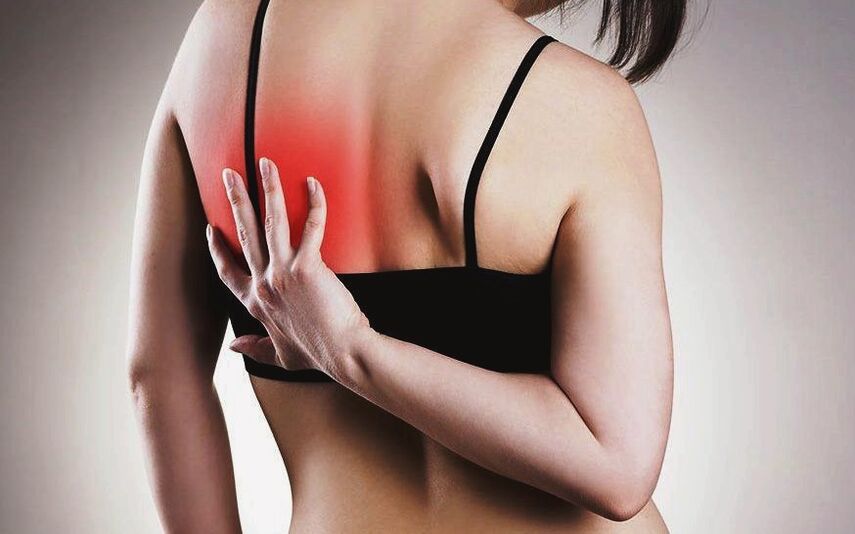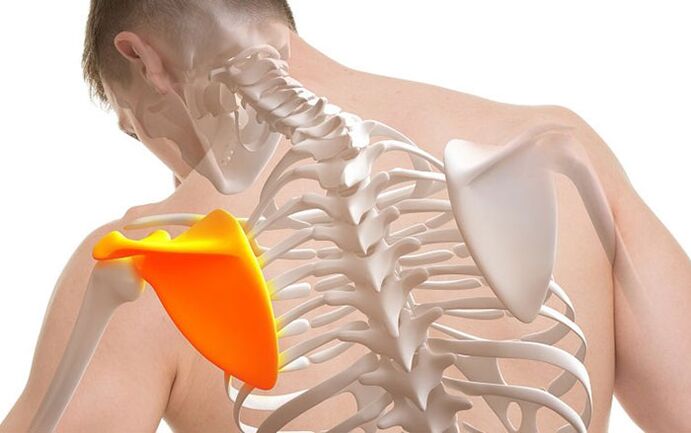
The most common diseases that cause pain under the left shoulder blade from behind from behind are osteochondrosis, angina pectoris, pneumonia, peptic ulcer and panic attacks. Along with pain syndrome, patients may be bothered by nausea, vomiting, heartburn, cough, phlegm production, as well as sensory and motor dysfunction. Diagnosis of the patient's condition is based on surveys, examinations, laboratory and instrumental studies. Treatment tactics depend on the cause of the disease.

cause
Pain under the left shoulder blade from behind from behind is a formidable symptom that can be observed in diseases of the spine or serious violations of the function of internal organs. At the same time, in 7% of cases, such pain syndromes occur due to surgical pathology that requires immediate surgical intervention.
Among the main causes of pain in the left shoulder blade area are:
- Spinal diseases (congenital malformations, ankylosing spondylitis, spondylosis, osteochondrosis, intervertebral hernias, etc. ), provoking spinal root compression;
- Muscle pathology (dermatomyositis, fibromyalgia, etc. ), which causes characteristic pain - myalgia;
- Neurological disorders (Guillain-Barré syndrome, polyneuropathy, intercostal neuralgia, etc. ), characterized by the appearance of certain neuropathic pain;
- Diseases of internal organs:
- Heart - angina pectoris, arrhythmias, heart attacks;
- Lungs-bronchitis, pneumonia, tuberculosis, pleurisy;
- Stomach - gastritis, ulcers, polyps;
- Spleen - rupture and other pathologies.
- "Blood cancer" (leukemia), because pain is noted in the thickness of the bone containing the bone marrow (pelvis, sternum, shoulder blades, tubular bone).
Sometimes the pain syndrome is provoked by disorders of the autonomic nervous system, which controls the work of all organs and systems. In such cases, we are talking about the exacerbation of vegetovascular dystonia - i. e. about panic attacks.
symptoms
The most common causes of pain below the left shoulder blade are osteochondrosis, angina pectoris, pneumonia, peptic ulcer or panic attacks.
Osteochondrosis
The disease is caused by the destruction of the intervertebral disc, which usually "softens" movement in the spinal space. Usually, the pathology occurs against the background of extreme physical exertion and the natural aging of the body.
So, a destroyed intervertebral disc (often in the cervical area) protrudes and violates the spinal roots. For this reason, the patient (next to the lesion) is concerned about acute pain in the back of the head and neck by spreading to the shoulder and shoulder blade area. Over time, superficial sensitivity is disturbed in this area, causing the patient not to feel temperature and vibration on the skin.
With the progression of the disease, the brachial plexus is involved in a pathological process, which greatly complicates the mobility of the shoulder. At the same time, the strength of the affected arm muscles is significantly weakened, which in further cases leads to immobilization.
angina pectoris
Angina pectoris is a pain syndrome that occurs in the chest, also known as "angina pectoris". The cause of pain is a violation of blood supply to the heart muscle due to vasoconstriction or the formation of cholesterol plaques in their lumen. Provokes stress attacks, emotional and physical burdens.
Usually, patients worry about stab pain or sudden burning in the chest area. In this case, the pain often spreads to the left shoulder blade, as well as along the ulnar surface of the left hand to the little finger. Often pain syndrome is combined with feelings of disturbance in the work of the heart and fear of death.
Pneumonia
Pneumonia is a disease, often provoked by a bacterial or viral infection. As a rule, patients complain of a significant increase in temperature (up to 39. 5-40 ° C), fever and pain "stabbing" in the chest or shoulder blades from the affected lungs. In this case, the pain is exacerbated by sneezing, coughing, or strong breathing.
With the development of the disease, coughing occurs and the separation of purulent sputum, which sometimes acquires the character of "rusty" (due to blood impurities). Patients often experience shortness of breath and shortness of breath even with little physical activity.
stomach ulcer
The cause of the disease is the local destruction of the gastric mucosa with the formation of peptic ulcers (i. e. , ulcers). Provocateurs are bacterial (Helicobacter) infections, hyperacidity and disorders of gastric motility.
The main complaint of peptic ulcer disease is paroxysmal pain in the upper abdomen (epigastrium), which occurs or intensifies after eating. Often, exacerbation of the disease is combined with nausea and vomiting, which brings relief. During the intercourse period, patients complained of heartburn, belching, bloating and heaviness after eating.
Vegetative crisis
The cause of the pain may be a crisis of vegetovascular dystonia, also known as a panic attack. Typically, patients are concerned about "migrating" pain, which occurs either in the heart area, or under the scapula, or in the abdomen, etc.
At the same time, patients complain of fever, sweating, trembling, shortness of breath, fear of going insane or confusion of mind.
Such a crisis can be a manifestation of both organic pathology (tumors of the adrenal glands, heart disease) and mental (phobias, depression, post-traumatic syndrome). In some cases, panic attacks are the result of taking medication.

Diagnostics
Diagnostic measures usually consist of:
- A survey that allows you to determine the conditions for the occurrence and nature of the pain;
- Clinical examination with explanation of pain localization and identification of pain points;
- Laboratory tests to detect infection (with pneumonia or ulcers), inflammatory changes in the blood or muscle protein levels, indicate its destruction (troponin in myocardial infarction);
- Instrumental methods use X-rays, ultrasound, CT or MRI.
Also, in the case of a heart attack, electrocardiography is performed, and in the case of stomach ulcers, fibrogastroduodenoscopy (examination of the abdomen with endoscopy).
Treatment
If pain occurs under the left shoulder blade from behind from behind, the patient should immediately seek medical help, because. Such pain syndromes may indicate anxiety (myocardial infarction, spleen rupture, ulcer perforation, etc. ). In this case, it is not recommended to take painkillers, because. analgesics can hide symptoms and complicate the subsequent diagnosis!
- Osteochondrosis. Basic therapies include nonsteroidal anti-inflammatory drugs and steroids. Muscle relaxation is used to relieve muscle spasms. As a long -term treatment aimed at slowing the destruction of the intervertebral disc, chondroprotectors are prescribed.
- Angina. Relief of acute attacks is done with the help of nitrates. However, general therapy is based on lifestyle changes, the use of acetylsalicylic acid (to "thin" the blood), as well as statins to lower cholesterol levels.
- Pneumonia. The main drug in the treatment of pneumonia is antibiotics, the choice of which depends on the causative agent of the infection.
- Stomach ulcer. Ulcer treatment consists of the destruction of provocative bacteria (Helicobacter pylori). For this purpose, several antibacterial agents are prescribed, as well as drugs that reduce the level of acidity of gastric contents.
- vegetative crisis. In most cases, panic attack treatment can be limited to psychotherapy sessions. At the same time, the appointment of psychotropic substances (antidepressants, sedatives) is often inappropriate.
Preventive measures
Prevention of pain under the left shoulder blade from behind from behind is based on:
- timely diagnosis of congenital and acquired diseases of the spine (consolidation of the cervical vertebrae, spondylosis, osteochondrosis, intervertebral hernias, injuries);
- early detection of muscle pathology (dermatomyositis, fibromyalgia);
- recovery of neurological disorders (intercostal neuralgia, polyneuropathy);
- treatment of diseases of internal organs:
- heart - angina pectoris, arrhythmias, heart attacks;
- lungs-bronchitis, pneumonia, pleurisy tuberculosis;
- stomach - gastritis, ulcers, polyps;
- spleen - rupture and other pathologies.
- perform blood screening tests for the purpose of pre-symptomatic diagnosis of leukemia.
Remember, pain in the left shoulder blade may indicate an acute pathology that requires emergency treatment or surgery!



































